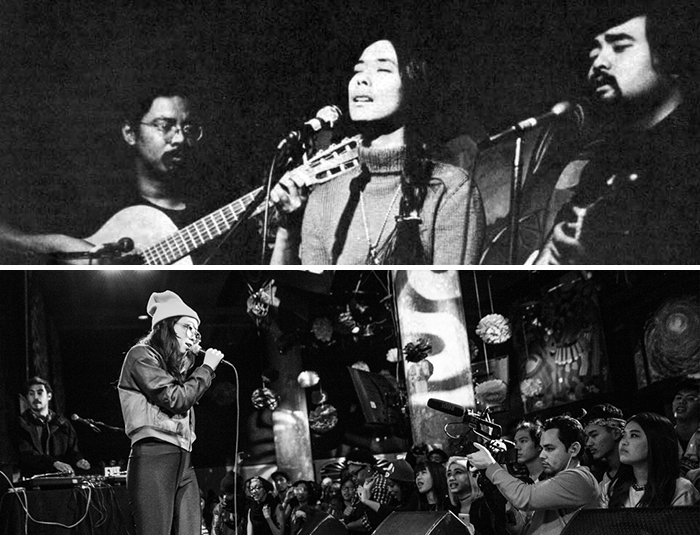October 3, 2015, marked the fiftieth anniversary of the Hart-Celler Act, better known as the Immigration and Nationality Act of 1965. For Asian Pacific Islander Americans, it brought an end to over eighty years of highly restrictive, discriminatory immigration policies, dating back to the first Chinese Exclusion Act of 1882. Following the 1965 act, Asian America was remade, creating distinct generational identities within the larger community. Music was a key way through which that diversity made its literal and proverbial voices heard.
1. Pat Suzuki – “Frenesi” (1960s)
Suzuki was one of the most successful of Asian American artists in the pre-1965 era. A second-generation Japanese American whose family was interned during World War II, Suzuki caught notice in the Seattle nightclub scene in the late 1950s. That led to a string of records, mostly of jazz standards, and then a successful run on Broadway with the 1958 production of Flower Drum Song.
2. Alika and the Happy Samoans – “Chow Mein Sandwich” (1970s)
Originally hailing from Hawaii, Alika and the Happy Samoans ended up as the house band for China Royale, a Chinese restaurant in Fall River, Massachusetts, that dates back to 1950. The chow mein sandwich— a Chinese American dish if ever there was one—dates back even earlier, at least as far back as the 1930s. The Happy Samoans recorded their ode to the sandwich on an early 1970s lounge album, supposedly recorded live at the China Royale. Just imagine the cocktails with their little umbrella swizzles.
3. A Grain of Sand – “We Are the Children” (1973)
When the trio of Nobuko Miyamoto, Chris Iijima, and William “Charlie” Chin released their debut album on the Paredon label (now part of Smithsonian Folkways Recordings) in 1973, they became the first group to record under the self-conscious banner of “Asian America.” Previously, the term had little meaning, politically or culturally, but the Asian American Movement of the early 1970s promoted a new, pan-ethnic identity of solidarity, exemplified on “We Are the Children,” one of the group’s first compositions and most enduring anthems.
4. The Jets – “You Got It All” (1988)
This family group of second generation Tongan Americans came out of the fertile Minneapolis R&B scene of the 1980s. They began to climb the charts by the mid-1980s and became the first group of Asian Pacific Islander descent to crack the pop Top 10. (The next group to follow in those footsteps were Far East Movement, and that took a quarter century). “You Got It All” was a big hit on the Adult Contemporary chart and remains a slow jam standard for a generation of 1980s babies.
5. Jon Jang – “Butterfly Lover’s Song” (1993)
Chinese American pianist Jon Jang was heavily influenced by the politics of the Asian American Movement and often tried to exemplify its themes in both his compositional approach and cross-cultural collaborations. Along with contemporaries like Fred Ho, Mark Izu, and the late Fred Ho(un), Jang used jazz as a medium to explore a nascent Asian American sensibility. His best known composition, “The Butterfly Lover’s Song,” takes a classic Chinese folk song and remakes it with a contemporary jazz aesthetic.
6. Jocelyn Enriquez – “Do You Miss Me?” (1996)
Dance music vocalist Jocelyn Enriquez grew up in the bustling Filipino American party scene of the 1980s and early 1990s San Francisco Bay Area. Originally led by teenage DJ crews, the scene embraced the up-tempo style known as Latin freestyle. While Enriquez also sang ballads, her enduring tracks have been freestyle jams like “Do You Miss Me?” and “A Little Bit of Ecstasy.”
7. Mountain Brothers – “Paperchase” (1996)
Asian Americans in hip-hop begin as far back with Joe “Afrofilipino” Bataan and his “Rap-O Clap-O” in 1979, but the real blossoming of talent came in the 1990s once a generation of Asian American youth, raised on hip-hop, came of age. The Mountain Brothers were a trio of Chinese American rappers from Philadelphia and managed to land a series of high-profile appearances, first on national advertising campaigns, then with an ill-fated, short-lived record deal that they abandoned to go the independent route instead. “Paperchase” was the first single they ever released on their own.
8. Awkwafina feat. Dumbfoundead – “Come Stop Me” (2014)
By the 2000s, the Internet-instigated transformation of music production and distribution meant that Asian American artists could reach audiences without having to deal with the same gauntlet of industry gatekeepers that had stymied earlier generations. Awkwafina and Dumbfounded, both Korean American rap artists representing Queens, New York, and Koreatown, Los Angeles, respectively, have been two of the standouts in an increasingly broad and diverse network of artists from across the musical spectrum.
Oliver Wang is an associate professor of sociology at California State University, Long Beach. He has also written on pop music, culture, and politics for a variety of publications, including NPR, the Los Angeles Times, and his own Soul Sides blog. In April 2015 he released his first academic book, Legions of Boom: Filipino American Mobile DJ Crews in the San Francisco Bay Area (Duke University Press).


